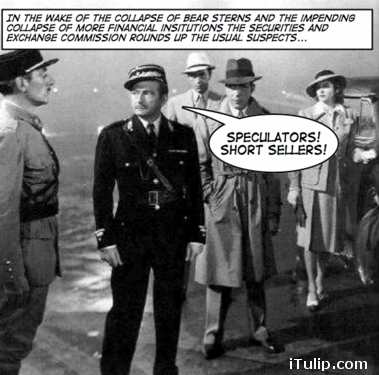 |
Naked short selling has dogged many firms for years but only became an urgent issue for the SEC to act on when the practice hit financial firms.
Securities covered by SEC short sale order
July 16, 2008 (Reuters)
The U.S. Securities and Exchange Commission issued an emergency order on Tuesday placing restrictions on the short selling of shares of certain major financial firms.
The SEC's order will require that anyone effecting a short sale in these securities arrange beforehand to borrow the securities and deliver them at settlement.
The order takes effect Monday, July 21, and will terminate at the end of July 29. The SEC said the order may be extended, but for no more than 30 calendar days in total duration.
The agency identified the following securities affected by its order:
BNP Paribas Securities Corp
Bank of America Corp
Barclays PLC
Citigroup Inc
Credit Suisse Group
What did the stock market do in response?July 16, 2008 (Reuters)
The U.S. Securities and Exchange Commission issued an emergency order on Tuesday placing restrictions on the short selling of shares of certain major financial firms.
The SEC's order will require that anyone effecting a short sale in these securities arrange beforehand to borrow the securities and deliver them at settlement.
The order takes effect Monday, July 21, and will terminate at the end of July 29. The SEC said the order may be extended, but for no more than 30 calendar days in total duration.
The agency identified the following securities affected by its order:
BNP Paribas Securities Corp
Bank of America Corp
Barclays PLC
Citigroup Inc
Credit Suisse Group
Stocks soar on drop in oil, Wells Fargo report
July 17, 2008 (AP)
Wall Street at least temporarily shrugged off some of its many concerns Wednesday and bounded higher thanks to a drop in oil prices. The Dow Jones industrial average rose 276 points, or 2.5 percent, posting its best daily gain in three months.
AntiSpin: The market did not rally yesterday because of a drop in the price of oil. Sometimes history does repeat. The text quoted from 1930 rebound from the Great Depression Crash of '29 refers to events in 1930 following the Stock Market Crash of 1929, the graphics and comments refer to similar events in 2008 following the Securitized Debt Market Crash of 2007.July 17, 2008 (AP)
Wall Street at least temporarily shrugged off some of its many concerns Wednesday and bounded higher thanks to a drop in oil prices. The Dow Jones industrial average rose 276 points, or 2.5 percent, posting its best daily gain in three months.
"There had been much talk about eliminating short selling. The NYSE now requested lists of all holders of borrowed stock (short sellers). The rush to cover to stay off the list and to realize profits assisted in ending the decline.
"The discount rate was reduced again, to 4 1/2%. Congress rushed a tax cut. Rockefeller ordered 1 million shares of Standard Oil at 50. An order for 50,000 shares of U.S. Steel at 150 "pegged" that speculative leader. Its drop from 261 3/4 to 165 had been the bellwether of the crash."
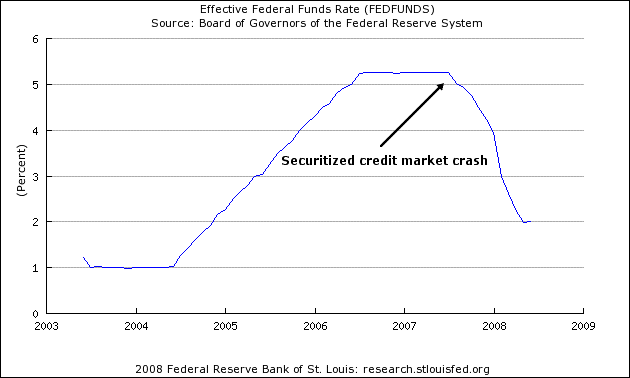
1930 following the stock market crash vs 2008 following the securitized debt market crash
"The gyrations quieted. The stock market rallied in quiet trading for the rest of November 1929.
"The new year, 1930, dawned bright, cheery and confident. A parade of business, financial, labor, academic and government leaders made page one news with reviews of promising business conditions and future growth. December retail sales reports were quite good. The stock market had edged steadily upwards during the last half of December despite year end cash selling and the continued unloading of the distress stock held by banks and brokers."
"Auto production, which hit a high of 621,910 units in April fell steadily thereafter to just 119,950 in December - the smallest monthly total since February, 1922. However, auto sales did not actually decline below the good levels of 1928 until the end of May, 1930. Some of the problem was in declining auto exports."
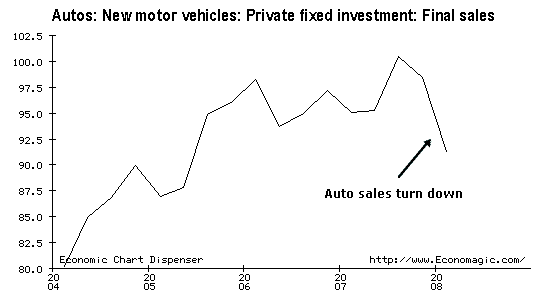
Auto sales started to decline late 2007.
"Business inventories were reportedly small and retail trade was holding up well. But business buying plans were cautious, and major cities like St. Louis and Chicago reported the cutting back of building plans and the laying off of workers. Manufacturing unemployment was up 500,000 since September, 1929."
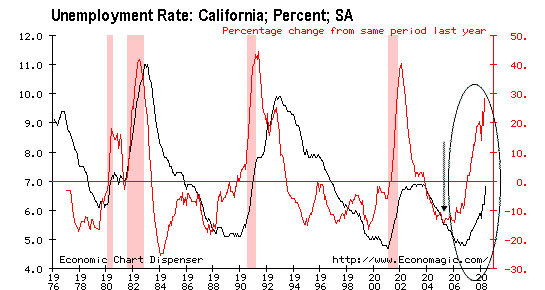
Unemployment rate in California, the 8th largest nation in the world in GDP, is rising rapidly.
"Depressed conditions continued unabated in Germany, Central Europe and England. Banks and brokers remained heavily burdened with distress stock. A large, confident short interest, well healed with recent profits, was reportedly operating in the stock market.""There were great expectations of a quick business revival in the spring of 1930. Credit was ample and available at low rates. Bank rates had been cut sharply by the Federal Reserve Bank and all the major European national banks. Private interest rates had been cut even faster and sharper as people with money found it increasingly difficult to profitably employ it. Not only were business risks rising, the profit inducement to borrow was clearly declining, making the availability of money at sharply declining interest rates increasingly irrelevant.
"Auto manufacturers increased steel orders, as auto inventories were at last worked down. Railroads, responding to a plea from Pres. Hoover, accelerated steel rail buying and other planned maintenance and capital projects. Many other public utilities and major industries responded similarly.
"However, primary interest rates continued declining all around the world. The Federal Reserve's discount rate was lowered to 3 1/2% in March. Textiles declined sharply, but retail trade otherwise remained fairly good. Banks reported an end to the decline in bank savings. Dividend payments, from 1929 earnings, were at record levels. Competitive pressures caused a boom in advertising, and farm implement purchases were running above 1929 levels."
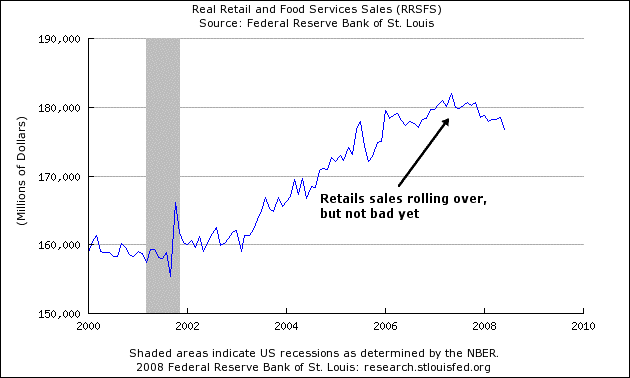
Retails trade has in 2008 otherwise remained fairly good.
"The higher wheat prices, a rise in steel production to about 80% of capacity, revived auto production and sales, and the general revival of domestic economic activity, pushed stock market prices higher. April auto production of 467,000 units was better than any April save April, 1929 - but the revival in auto production would probably have been about 40,000 units higher that month but for the collapse of its export market.
"Total NYSE stocks reached just under $80 billion by April 10, 1930, making up about 73% of its losses since its September, 19, 1929 highs. The Big Board had surged about $30 billion in five months, a gain of about 65%. Its loss from its September, 19, 1929 highs, was just about 12%. Bond prices were running above 1929 levels.
"Federal taxes were cut substantially and public works projects were accelerated. Steel production rebounded to 69% of capacity and continued climbing towards its usual March-April peak."
"Business failures were up sharply - the most since 1922. Failures in men's wear rose spectacularly - as usual during depressions. Textile inventories rose 25% for the quarter despite a 12% reduction in production. Construction was depressed. New York cement mills were operating at only half of capacity. By the end of April, employment had dropped 8.5% since the Crash."
"There were 124 bank failures - mostly small rural banks - with $51.5 million in liabilities, in the first quarter of 1930. Real estate losses were heavier than the losses in the stock markets, and second mortgages took a beating. Small rural banks with large holdings of land mortgages were badly hurt. However, the figures were as yet no worse than for the previous economic downturns in 1924, 1925, and 1927, from which recovery had always quickly followed."
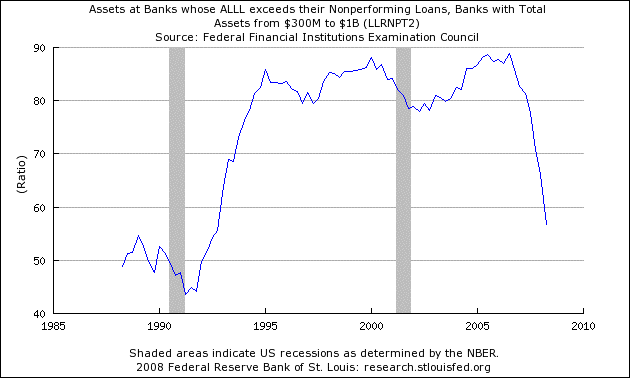
iTulip says: History is the language in which the dead speak to the deaf."The discount rate was reduced again, to 4 1/2%. Congress rushed a tax cut. Rockefeller ordered 1 million shares of Standard Oil at 50. An order for 50,000 shares of U.S. Steel at 150 "pegged" that speculative leader. Its drop from 261 3/4 to 165 had been the bellwether of the crash."

1930 following the stock market crash vs 2008 following the securitized debt market crash
"The gyrations quieted. The stock market rallied in quiet trading for the rest of November 1929.
"The new year, 1930, dawned bright, cheery and confident. A parade of business, financial, labor, academic and government leaders made page one news with reviews of promising business conditions and future growth. December retail sales reports were quite good. The stock market had edged steadily upwards during the last half of December despite year end cash selling and the continued unloading of the distress stock held by banks and brokers."
"Auto production, which hit a high of 621,910 units in April fell steadily thereafter to just 119,950 in December - the smallest monthly total since February, 1922. However, auto sales did not actually decline below the good levels of 1928 until the end of May, 1930. Some of the problem was in declining auto exports."

Auto sales started to decline late 2007.
"Business inventories were reportedly small and retail trade was holding up well. But business buying plans were cautious, and major cities like St. Louis and Chicago reported the cutting back of building plans and the laying off of workers. Manufacturing unemployment was up 500,000 since September, 1929."

Unemployment rate in California, the 8th largest nation in the world in GDP, is rising rapidly.
"Depressed conditions continued unabated in Germany, Central Europe and England. Banks and brokers remained heavily burdened with distress stock. A large, confident short interest, well healed with recent profits, was reportedly operating in the stock market."
Europe, which held the world’s economic storms at bay for the last year, has finally succumbed. - New York Times, July 16, 2008
"Auto manufacturers increased steel orders, as auto inventories were at last worked down. Railroads, responding to a plea from Pres. Hoover, accelerated steel rail buying and other planned maintenance and capital projects. Many other public utilities and major industries responded similarly.
"However, primary interest rates continued declining all around the world. The Federal Reserve's discount rate was lowered to 3 1/2% in March. Textiles declined sharply, but retail trade otherwise remained fairly good. Banks reported an end to the decline in bank savings. Dividend payments, from 1929 earnings, were at record levels. Competitive pressures caused a boom in advertising, and farm implement purchases were running above 1929 levels."

Retails trade has in 2008 otherwise remained fairly good.
"The higher wheat prices, a rise in steel production to about 80% of capacity, revived auto production and sales, and the general revival of domestic economic activity, pushed stock market prices higher. April auto production of 467,000 units was better than any April save April, 1929 - but the revival in auto production would probably have been about 40,000 units higher that month but for the collapse of its export market.
"Total NYSE stocks reached just under $80 billion by April 10, 1930, making up about 73% of its losses since its September, 19, 1929 highs. The Big Board had surged about $30 billion in five months, a gain of about 65%. Its loss from its September, 19, 1929 highs, was just about 12%. Bond prices were running above 1929 levels.
"Federal taxes were cut substantially and public works projects were accelerated. Steel production rebounded to 69% of capacity and continued climbing towards its usual March-April peak."
Many economists have concluded that a second dose of government stimulus spending is required to prevent a broad economic unraveling and provide relief to millions of Americans grappling with joblessness, plunging home prices and tight credit. - New York Times, July 16, 2008
Business failures up 17.5pc in six months. - Telegraph UK, July 15, 2008

After the failure of $18 billion IndyMac, nervous investors mull more potential bank failures. - Marketwatch, July 14, 2008
iTulip Select: The Investment Thesis for the Next Cycle™
__________________________________________________
To receive the iTulip Newsletter or iTulip Alerts, Join our FREE Email Mailing List
Copyright © iTulip, Inc. 1998 - 2007 All Rights Reserved
All information provided "as is" for informational purposes only, not intended for trading purposes or advice. Nothing appearing on this website should be considered a recommendation to buy or to sell any security or related financial instrument. iTulip, Inc. is not liable for any informational errors, incompleteness, or delays, or for any actions taken in reliance on information contained herein. Full Disclaimer
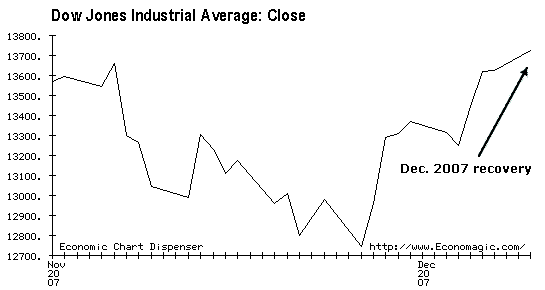

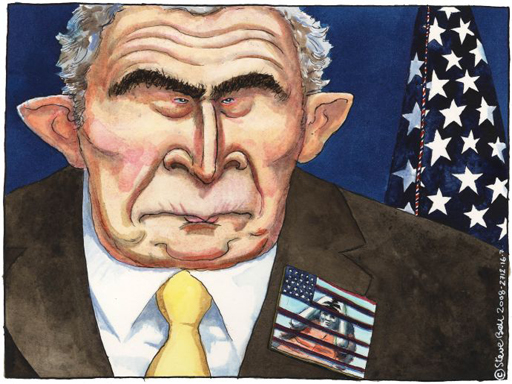
Comment